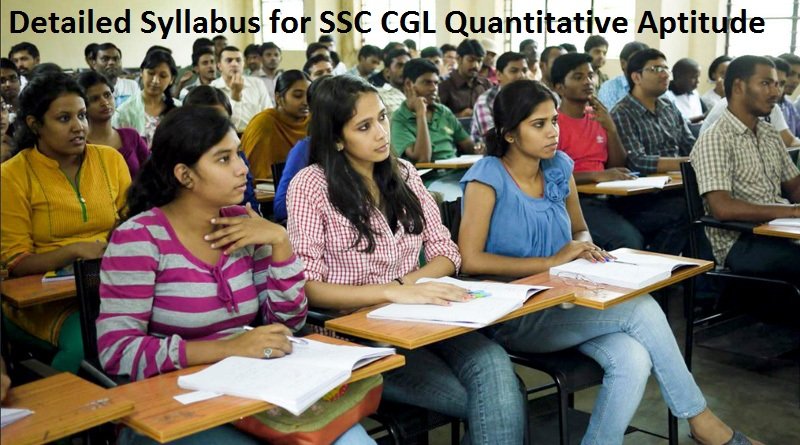SSC CGL Quantitative Aptitude section mathematical ability को test करता है। यह section SSC CGL के दोनों Tiers (Tier I & Tier II) में आता है और exam में high-scoring area माना जाता है। इस section में concepts को अच्छे से समझकर और regular practice के साथ आप high score कर सकते हैं।
Tier I में 25 questions होते हैं, जो 50 marks के होते हैं, और Tier II में Quantitative Aptitude section का overall weightage ज्यादा होता है। नीचे SSC CGL Quantitative Aptitude (Tier I & Tier II) का detailed syllabus दिया गया है:
SSC CGL Quantitative Aptitude (Tier I)
Tier I में Quantitative Aptitude section fundamental math concepts पर आधारित होता है। इसमें चार broad areas होते हैं: Arithmetic, Algebra, Geometry, और Trigonometry।
1. Arithmetic (अंकगणित)
(A) Percentage (प्रतिशत)
- किसी quantity का प्रतिशत निकालना, percentage change (increase या decrease), और real-life situations में percentages का use।
- Example: A का 20% B से ज्यादा है, अगर B = 500 है, तो A क्या होगा?
Preparation Tip:
Percentage के basic formulas को याद रखें और word problems पर ध्यान दें।
(B) Ratio and Proportion (अनुपात और समानुपात)
- Ratio concepts, Proportion, और direct और indirect proportionality पर आधारित questions।
- Example: अगर तीन संख्याएँ 2:3:5 के अनुपात में हैं, और उनका कुल योग 100 है, तो सबसे बड़ी संख्या क्या है?
Preparation Tip:
Ratios और Proportions के applications (mixing, partnership) को समझें और practice करें।
(C) Profit and Loss (लाभ और हानि)
- Cost Price (CP), Selling Price (SP), Marked Price (MP), और Discount पर आधारित problems।
- Example: अगर किसी वस्तु की कीमत 500 रुपए है और 10% का लाभ हुआ, तो वस्तु का विक्रय मूल्य क्या होगा?
Preparation Tip:
Profit & Loss के सभी formulas को समझें और mark-up & discount को अच्छी तरह से practice करें।
(D) Simple Interest and Compound Interest (साधारण ब्याज और चक्रवृद्धि ब्याज)
- Interest calculation और Compound Interest का application।
- Example: अगर किसी राशि पर 2 साल के लिए 10% प्रति वर्ष साधारण ब्याज मिलता है, तो 1000 रुपए की राशि का ब्याज कितना होगा?
Preparation Tip:
SI और CI के formulas और compound interest की stepwise calculation को समझें।
(E) Time and Work (समय और कार्य)
- Efficiency-based problems, Work और Time के बीच relation, और different persons या machines द्वारा किए गए काम की तुलना।
- Example: A अकेले किसी काम को 10 दिन में करता है, जबकि B अकेले उसे 15 दिन में करता है। अगर वे दोनों साथ में काम करें, तो काम कितने दिन में पूरा होगा?
Preparation Tip:
Efficiency और LCM method का use करके questions solve करें।
(F) Time, Speed, and Distance (समय, गति और दूरी)
- Speed, distance, time के बीच relation, और Relative Speed, Boat & Stream, और Train-related problems।
- Example: एक व्यक्ति 60 km/h की गति से 3 घंटे चला। उसने कितनी दूरी तय की?
Preparation Tip:
Speed, Distance, और Time के relation को अच्छे से समझें और train, boat & stream questions को solve करें।
(G) Averages (औसत)
- Average, weighted average, और combined average पर आधारित problems।
- Example: 5 संख्याओं का औसत 40 है, अगर छठी संख्या जोड़ दी जाए और औसत 42 हो जाए, तो छठी संख्या क्या है?
Preparation Tip:
Average के basic concepts को समझें और weighted average problems पर practice करें।
(H) Partnership (साझेदारी)
- Business partnership और profit-sharing ratio पर आधारित problems।
- Example: अगर A और B किसी business में 3:2 के अनुपात में invest करते हैं और उन्हें 5000 का लाभ होता है, तो B का हिस्सा क्या होगा?
Preparation Tip:
Partnership problems में ratios और profit sharing concepts को समझें।
(I) Mixture and Alligation (मिश्रण और अनुपात)
- Two or more mixtures को मिलाकर resulting mixture के concentration को find करना।
- Example: 20% alcohol वाले 30 liters के मिश्रण में कितने liters pure alcohol मिलाना होगा जिससे नया मिश्रण 30% alcohol वाला हो?
Preparation Tip:
Mixture and Alligation के concepts को visual diagrams से समझें।
2. Algebra (बीजगणित)
(A) Simplification (सरलीकरण)
- Algebraic expressions को simplify करना।
- Example: (x² – 5x + 6) / (x – 2) को simplify करें।
Preparation Tip:
Simplification में BODMAS और algebraic identities का सही use करें।
(B) Linear & Quadratic Equations (रेखीय और द्विघात समीकरण)
- Linear और Quadratic equations को solve करना।
- Example: x² – 5x + 6 = 0 को solve करें।
Preparation Tip:
Quadratic equations के solutions के लिए factorization और quadratic formula का use करें।
3. Geometry (ज्यामिति)
(A) Basic Geometry (मूल ज्यामिति)
- Angles, Triangles, Circles, और Quadrilaterals पर आधारित problems।
- Example: किसी triangle में तीन कोण क्रमशः 30°, 60°, और 90° हैं, triangle की type क्या होगी?
Preparation Tip:
Basic geometric properties और theorems को याद रखें। Geometry में diagram बनाकर solve करें।
(B) Mensuration (क्षेत्रमिति)
- 2D और 3D shapes जैसे Square, Rectangle, Circle, Sphere, और Cylinder की area, perimeter, और volume को calculate करना।
- Example: किसी cylinder की ऊँचाई 10 cm और आधार का radius 7 cm है, तो उसका आयतन क्या होगा?
Preparation Tip:
Mensuration formulas को याद रखें और area/volume-based problems को solve करें।
4. Trigonometry (त्रिकोणमिति)
(A) Trigonometric Ratios (त्रिकोणमितीय अनुपात)
- Sin, Cos, Tan और इनके ratios का use करके problems को solve करना।
- Example: अगर Sin θ = 1/2 है, तो θ का मान क्या होगा?
Preparation Tip:
Trigonometric ratios और identities को याद करें और उनकी applications को practice करें।
5. Data Interpretation (आँकड़ा विश्लेषण)
- Data Interpretation में graphs, charts, tables, और pie charts से जुड़े problems होते हैं।
- Example: नीचे दिए गए bar graph के आधार पर सवालों के उत्तर दें।
Preparation Tip:
Tables, graphs, और charts को जल्दी और accurately interpret करने की practice करें।
SSC CGL Quantitative Aptitude (Tier II)
Tier II में Quantitative Aptitude का syllabus थोड़ा advanced होता है और इसमें deeper knowledge और faster calculations की जरूरत होती है। Tier II में इन topics को detail में पूछा जाता है:
1. Advanced Arithmetic
- LCM और HCF
- Surds and Indices
- Percentage, Profit & Loss
- Simple & Compound Interest
- Time & Work
- Time, Speed & Distance
- Ratio & Proportion
- Averages, Mixtures, और Alligation
2. Algebra
- Polynomials
- Quadratic equations
- Algebraic identities और Simplifications
3. Geometry & Mensuration
- Triangles, Circles, और Quadrilaterals के advanced concepts
- 3D shapes (Cylinders, Spheres, Cubes) का volume, surface area और other properties
4. Trigonometry
- Height and Distance-based questions
- Trigonometric identities और advanced ratios
5. Data Interpretation (DI)
- Advanced Data Interpretation questions
- Pie charts, Bar Graphs, और Line Graphs
Conclusion:
SSC CGL Quantitative Aptitude section की तैयारी के लिए आपको conceptual clarity, formulas का सही understanding, और regular practice की जरूरत है। Tier I और Tier II दोनों levels के लिए speed और accuracy पर focus करें। Mock tests और previous year question papers solve करके खुद को exam conditions में डालें।









